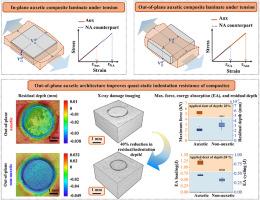面内与面外辅助结构:层状复合材料结构的解耦抗拉强度和抗压痕性能
IF 9.8
1区 材料科学
Q1 MATERIALS SCIENCE, COMPOSITES
引用次数: 0
摘要
增生性层状复合材料具有优异的抗压痕和抗冲击性能,但其应用往往受到抗拉强度的关键权衡的阻碍。本研究首先系统地量化了这种妥协,通过综合实验和理论分析证明,与非辅助设计相比,平面内辅助设计牺牲了一半以上的极限抗拉强度。这一弱点被证实是由于横向应变放大导致过早失效。然而,这项工作的核心贡献是解决了这一长期存在的困境。我们提出了一种面外辅助结构的设计和验证,该结构消除了拉伸损失,与刚度匹配的非辅助结构相比,达到了相当的拉伸强度。此外,这种拉伸友好型设计在抗压痕方面表现出显着的增强。在准静态压痕下,它承受更高的载荷,并且显示出超过40%的永久性压痕。显微ct分析揭示了能量吸收机理。补缺效应通过促进广泛的、能量耗散的内部分层来减轻损害。最终,本研究证明了拉伸权衡不是一个内在的差距,而是一个可解决的设计挑战。它为多功能复合材料提供了一条清晰的道路,这些复合材料同时具有拉伸可靠性和抗压痕性,显著提高了它们在高要求结构应用中的潜力。本文章由计算机程序翻译,如有差异,请以英文原文为准。

In-plane vs. out-of-plane auxetic architecture: Uncoupling tensile strength and indentation resistance of layered composite structures
Auxetic layered composites offer exceptional resistance to indentation and impact, but their application is often hindered by a critical trade-off in tensile strength. This study first systematically quantifies this compromise, demonstrating through integrated experimental and theoretical analysis that an in-plane auxetic design sacrifices over half its ultimate tensile strength compared to a non-auxetic counterpart. This weakness is confirmed to originate from transverse strain amplification that promotes premature failure. The central contribution of this work, however, is the resolution of this long-standing dilemma. We present the design and validation of an out-of-plane auxetic architecture that eliminates the tensile penalty, achieving a comparable tensile strength compared to its stiffness-matched, non-auxetic counterpart. Furthermore, this tensile-friendly design exhibits a remarkable enhancement in indentation resistance. Under quasi-static indentation, it sustains higher loads and shows over 40 % less permanent indentation. The micro-CT analysis reveals the energy absorption mechanism. The auxetic effect mitigates damage by promoting widespread, energy dissipating internal delamination. Ultimately, this research proves that the tensile trade-off is not an intrinsic gap but a solvable design challenge. It provides a clear pathway toward multifunctional composites that are simultaneously tensile reliable and indentation resistant, significantly advancing their potential for demanding structural applications.
求助全文
通过发布文献求助,成功后即可免费获取论文全文。
去求助
来源期刊

Composites Science and Technology
工程技术-材料科学:复合
CiteScore
16.20
自引率
9.90%
发文量
611
审稿时长
33 days
期刊介绍:
Composites Science and Technology publishes refereed original articles on the fundamental and applied science of engineering composites. The focus of this journal is on polymeric matrix composites with reinforcements/fillers ranging from nano- to macro-scale. CSTE encourages manuscripts reporting unique, innovative contributions to the physics, chemistry, materials science and applied mechanics aspects of advanced composites.
Besides traditional fiber reinforced composites, novel composites with significant potential for engineering applications are encouraged.
 求助内容:
求助内容: 应助结果提醒方式:
应助结果提醒方式:


